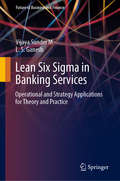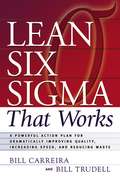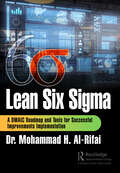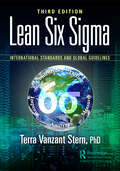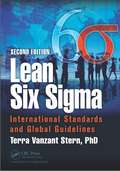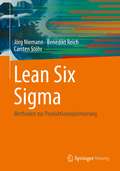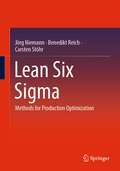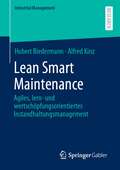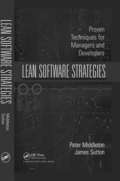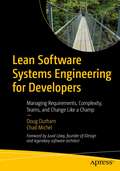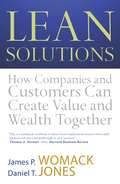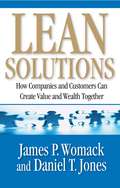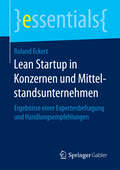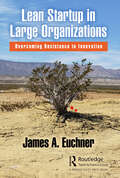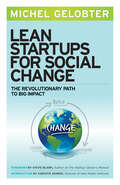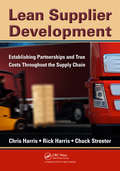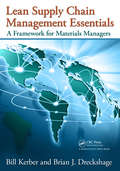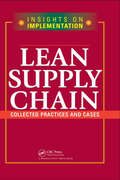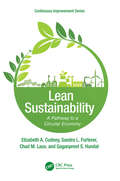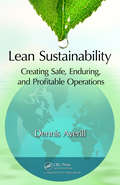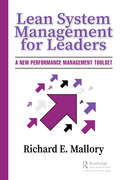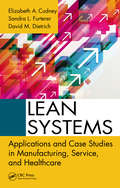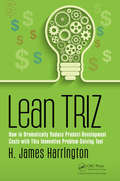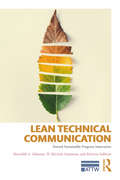- Table View
- List View
Lean Six Sigma im Bankensektor: Operative und strategische Anwendungen für Theorie und Praxis
by Vijaya Sunder M L. S. GaneshDieses Buch untersucht eine Reihe möglicher Wege, Modelle sowie operativer und strategischer Ansätze für Lean Six Sigma (LSS), eine zeitgemäße Praxis der kontinuierlichen Verbesserung (CI) zur Erzielung eines qualitätsbasierten Wettbewerbsvorteils in Organisationen. Fallstudien von Lean-Six-Sigma-Projekten in Bankunternehmen helfen, die operativen Dimensionen von LSS zu veranschaulichen, während die hier vorgestellten fallspezifischen und fallübergreifenden Analysen den strategischen Wert von LSS demonstrieren. Die Falldaten, die zur Gewinnung der Erkenntnisse herangezogen wurden, stammen zwar aus dem Bankensektor, ermöglichen jedoch eine Verallgemeinerung über den Bank- und Finanzdienstleistungssektor hinaus.Das Buch vertritt die Auffassung, dass LSS nicht nur eine KI-Praxis ist, sondern eine übergeordnete organisatorische Fähigkeit, genauer gesagt eine dynamische Fähigkeit, die es Unternehmen ermöglicht, einen auf Qualität basierenden Wettbewerbsvorteil zu erzielen. Das Buch richtet sich an Praktiker und Forscher gleichermaßen und schafft ein Gleichgewicht zwischen Theorie und Praxis.Für Praktiker bietet es einen Leitfaden für den Einsatz von LSS zur Erzielung von Wettbewerbsvorteilen und für evidenzbasierte Praktiken im Qualitätsmanagement und der operativen Exzellenz. Für Wissenschaftler stellt es eine Fülle von Literatur vor und erweitert den Wissensschatz zum Qualitätsmanagement. Dementsprechend ist das Buch sowohl für Praktiker als auch für Forscher von unschätzbarem Wert, da es ersteren hilft, den Wert von LSS sowohl als operative als auch als strategische Ressource zu erschließen, und letzteren potenzielle Forschungsrichtungen und Anwendungen aufzeigt."Dieses Buch vermittelt ein tiefes Verständnis der Lean Six Sigma-Anwendungen. Es inspiriert, indem es die Prinzipien des Konzepts auf ungewöhnliche Bereiche von Betrieb und Management jenseits des üblichen Qualitäts- und Projektmanagements überträgt. Beim Lesen des Buches kam mir die großartige Idee, Lean Six Sigma auch in meinem digitalen Unternehmenanzuwenden. Am Ende des Buches hatte ich den Eindruck, dass die Möglichkeiten für den richtigen Einsatz von Lean Six Sigma grenzenlos sind, insbesondere wenn man es aus der Perspektive der dynamischen Fähigkeiten betrachtet. Die Leser dieses Buches werden sicherlich Einblicke in die Verbesserung ihrer Geschäftsprozesse sowohl in operativer als auch in strategischer Hinsicht erhalten. Obwohl sich das Buch auf den Bankensektor konzentriert, eignet es sich eigentlich für ein sehr breites Publikum. Es handelt sich um eine brillante Forschungsarbeit und ein Buch, das als Leitfaden für die Transformation durch das Prisma von Lean Six Sigma dienen wird."- Professorin. Dr. ZornitsaYordanova, Leitende Assistenzprofessorin für Innovationsmanagement, Universität für nationale und internationale Wirtschaft, Sofia, Bulgarien"Lean Six Sigma muss aus einer Systemperspektive heraus verstanden werden, undes besteht eine große Wissenslücke in diesem Bereich, wenn es darum geht, ganzheitliche Lösungen für Geschäftsprobleme zu finden. Dieses Buch ist ein sehr willkommenes Werk, das diese Forderung aufgreift. Es integriert die Ressourcen des Qualitätsmanagements und die Sichtweise der dynamischen Fähigkeiten in die Praxis. Der Bereich Banken und Finanzdienstleistungen wurde passend gewählt, da er für Sozialunternehmen am unmittelbarsten anwendbar ist. Jeder, der mit weniger Mitteln mehr Wirkung erzielen möchte, wird von der Lektüre dieses Buches profitieren.-Alex Abraham, Hauptgeschäftsführer, Lean Success Partners, Winnipeg, Manitoba, Kanada"Das Buch ist eine erfrischende Bereicherung für die Welt des Qualitätsmanagements, insbesondere im Kontext von Banken und Finanzdienstleistungen. Konzepte und Begriffe wie "Schnelligkeit von Lean & Robustheit von Six Sigma zur Lösung operativer Probleme" "Hybride Methodik" passen sehr gut zu dem, was wir heute in der Branche tun.Ein weiterer interessanter Aspekt des Buches ist die Anwendung des "Dynamic Capabilities"-Ansatze
Lean Six Sigma in Banking Services: Operational and Strategy Applications for Theory and Practice (Future of Business and Finance)
by Vijaya Sunder M L. S. GaneshThis book explores a range of prospective avenues, models, and operational and strategic approaches to Lean Six Sigma (LSS), a contemporary Continuous Improvement (CI) practice for achieving a quality-based competitive edge in organisations. Lean Six Sigma project case studies from banking organizations help to illustrate the operational dimensions of LSS, while the case-specific and cross-case analyses presented here demonstrate its strategic value. While the case data used to arrive at the findings come from the Banking firms, it allows generalizability beyond the Banking and Financial Services sector. The book contends that LSS is not merely a CI practice, but a higher-order organizational capability, more precisely a dynamic capability, that allows firms to gain a competitive edge based on quality. Addressing the interests of practitioners and researchers alike, the book strikes a balance between theory and practice. For practitioners, it offers guidance on using LSS to gain a competitive advantage, and on evidence-based practice in quality management and operational excellence. For researchers, it presents a wealth of literature and expands the body of knowledge on quality management. Accordingly, the book is of immense value to both practitioners and researchers, helping the former unlock the value of LSS as both an operational and strategic resource, and highlighting potential research directions and applications for the latter.“This book provides a deep understanding of Lean Six Sigma applications. It inspires by transferring the principles of the concept into uncommon areas of operations and management behind the usual quality and project management. While reading the book I got hit by a great idea of applying Lean Six Sigma in my digital business as well. My impression at the end of the book was that sky is the limit for the right employment of Lean Six Sigma, especially while viewing it from a dynamic capabilities’ lens. Readers of this book will surely receive insights for improving their business processes both operationally and strategically. Although the book is focused on banking, it is actually suitable for a really wide audience. This is a brilliant piece of research as a book that will serve as a guide for transformation by the prism of Lean Six Sigma.” - Professor. Dr. ZornitsaYordanova, Chief Assistant Professor of Innovation Management, University of National and World Economy, Sofia, Bulgaria “Lean Six Sigma needs to be understood from a systems perspective and there exists a huge knowledge gap in this area of finding holistic solutions to business problems. This book is a very welcome work that addresses this call. It integrates quality management resources and dynamic capabilities view towards practice. Banking and Financial Services was aptly chosen as it has the most direct applicability for social enterprises. Anyone interested in creating more impact with less will surely benefit from reading the book” -Alex Abraham, Chief Executive Officer, Lean Success Partners, Winnipeg, Manitoba, Canada “The book is a refreshing booster to the world of Quality Management especially in the context of Banking and Financial Services. Concepts and terms like “Rapidness of Lean & robustness of Six Sigma to solve operational problems” “Hybrid methodology” resonate very well with what we do in the industry today. Another interesting fact about the book is applying “Dynamic Capabilities approach” to Quality Management, that sets a fresh Quality Oven and ensures this book is definitely a good investment of authors’ intellect.Best part – Even if a reader is new to the world of Quality,this book will be appropriate and resonating. For Researchers and Practitioners, both being leaders orfresh entrants, this book stands out to be a must-read, as it demonstrates the success of the Lean Six Sigma methodology via case studies and practical applications.” -Udit Salvan, Di
Lean Six Sigma that Works: A Powerful Action Plan for Dramatically Improving Quality, Increasing Speed, and Reducing Waste
by Bill Carreira Bill TrudellIf lean manufacturing moves your products through processes faster, and Six Sigma improves their quality, just imagine what combining these two powerful disciplines will do for you Lean Six Sigma That Works provides the key to transforming your results in any manufacturing environment, giving you detailed, practical processes that let you leave the conference room, and get right to work.
Lean Six Sigma: A DMAIC Roadmap and Tools for Successful Improvements Implementation
by Mohammad H. Al-RifaiThis book is a comprehensive guide that equips organizations and individuals with the necessary tools and knowledge to streamline operations, optimize resources, and deliver superior customer value through implementing lean Six Sigma methodologies. It provides a practical roadmap for achieving process, product, and service improvement. The book introduces readers to the powerful framework of lean Six Sigma, combining lean and Six Sigma methodologies. It takes readers through the DMAIC model – Define, Measure, Analyze, Improve, and Control – providing a structured approach to identifying inefficiencies, reducing defects, and enhancing overall business performance. It covers essential topics such as lean Six Sigma leadership, change management, project management, and a detailed explanation of each phase of the DMAIC process. This book is designed to cater to a diverse audience, including executives, managers, quality professionals, improvement professionals, engineers, operations professionals, customer service professionals, and students. The book offers practical knowledge, tools, and case studies to drive transformative change and build a sustainable competitive advantage.
Lean Six Sigma: International Standards and Global Guidelines
by Terra Vanzant Stern, PhDA hybrid methodology, Lean Six Sigma (LSS) is designed to accommodate global challenges and constraints by capitalizing on Six Sigma and Lean Thinking. LSS incorporates best practices from programs such as the International Organization for Standardization (ISO), Capability Maturity Model, and Total Quality Management. International LSS practitioners must understand the dynamics of LSS, along with its cultural aspects and regulations. Lean Six Sigma: International Standards and Global Guidelines provides this understanding. This book assumes that the overall goal of operational excellence is to ensure that organizational tasks and activities are being performed to the best of their process capabilities. It defines continuous improvement as activities that support and empower environments to make flexible decisions that lead to ongoing improvement and effectiveness. Coverage includes: New global LSS standards International implementation of process improvement programs New international LSS applications International LSS areas of competency This book defines many of the terms popularized by process improvement programs, such as center of excellence and business transformation. It documents these practices and explains how to perform future activities in accordance with the recorded practices. Exploring international approaches to LSS, it details the new ISO Standard for Six Sigma and also addresses the role of project management in LSS. Illustrating the synergies between Lean and Six Sigma and how they partner with other process improvement programs and initiatives, this book is an ideal study guide for those preparing to take the LSS Black Belt certification exam. This third edition covers important updates, such as: How innovation is being integrated The way in which Lean leadership is now being accomplished globally Newer case studies with specific attention to how Lean and Six Sigma are being monitored in healthcare and government Highlighting updated successes and the consideration of diversity and equity issues as they relate to LSS
Lean Six Sigma: International Standards and Global Guidelines, Second Edition
by Terra Vanzant Stern PhDA hybrid methodology, Lean Six Sigma (LSS) is designed to accommodate global challenges and constraints by capitalizing on Six Sigma and Lean Thinking. LSS incorporates best practices from programs such as the International Organization for Standardization (ISO), Capability Maturity Model, and Total Quality Management.International Lean Six Sigma p
Lean Six Sigma: Methoden zur Produktionsoptimierung
by Jörg Niemann Benedikt Reich Carsten StöhrDie Lean Six Sigma Werkstatt beschreibt wichtige praxisrelevante Methoden und Werkzeuge in der Optimierung von industriellen Produktionsstrukturen. Neben den theoretischen Grundlagen wird für jede Methode umfangreiches „Hands-on“ Übungsmaterial mit Lösungen bereitgestellt, um eine anwendungsnahe Wissensvermittlung zu gewährleisten. Das Buch unterstützt damit insbesondere Lehrende und Lernende bei der Vorbereitung und Durchführung ganzer Unterrichtseinheiten, die dann als Gruppenarbeiten in 13 Workshops vertiefend eingeübt und praxisnah durchgespielt werden können. Die spielerische Anwendung der Theorie über mehrere Spielrunden befähigt die Lernenden, die Methoden in der Praxis zu nutzen und den Erkenntnisgewinn im industriellen Umfeld anzuwenden.
Lean Six Sigma: Methods for Production Optimization
by Jörg Niemann Benedikt Reich Carsten StöhrThe Lean Six Sigma Workshop describes important and practically relevant methods and tools for optimizing industrial production structures. In addition to theoretical foundations, the book provides extensive hands-on exercise materials with solutions for each method, ensuring application-oriented knowledge transfer. The book particularly assists educators and learners in preparing and conducting entire teaching units, which can be deepened and practically applied through 13 workshops as group activities.The playful application of theory over multiple game rounds enables learners to use the methods in practice and apply gained insights in an industrial setting.
Lean Smart Maintenance: Agiles, lern- und wertschöpfungsorientiertes Instandhaltungsmanagement (Industrial Management)
by Hubert Biedermann Alfred KinzProduzierende Unternehmen müssen sich mehr denn je im globalen Wettbewerb in einem dynamischen Umfeld behaupten. Faktoren wie Volatilität, Unsicherheit, Komplexität und Ambiguität treten teilweise zeitgleich auf. Die fortschreitende Digitalisierung – Industrie 4.0 – wird hierbei als Chance im Umgang mit diesen Herausforderungen gesehen. Für Industriebetriebe bringt diese den Wandel zur Smart Factory und verlangt von der Instandhaltung, die als Enabler und Treiber dieser angesehen wird, ebenfalls einen Wandel. Wesentlicher Entwicklungsbedarf besteht in den Bereichen Wissensmanagement, Qualifikation, Datenmanagement, Dynamisierung der Instandhaltungsstrategie, flexible und agile Gestaltung der Instandhaltung sowie ganzheitliche wertschöpfungsorientierte Ausrichtung. Der vorliegende Band zeigt daher, dass die Instandhaltung als strategischer Erfolgsfaktor eines produzierenden Unternehmens agil, lern- und wertschöpfungsorientiert werden muss.
Lean Software Strategies: Proven Techniques for Managers and Developers
by Peter Middleton James SuttonLean production, which has radically benefited traditional manufacturing, can greatly improve the software industry with similar methods and results. This transformation is possible because the same overarching principles that apply in other industries work equally well in software development. The software industry follows the same industrial concepts of production as those applied in manufacturing; however, the software industry perceives itself as being fundamentally different and has largely ignored what other industries have gained through the application of lean techniques.
Lean Software Systems Engineering for Developers: Managing Requirements, Complexity, Teams, and Change Like a Champ
by Doug Durham Chad MichelGraduate to the next level of your software development career, learning the tools you need to successfully manage the complexity of modern software systems.Whether you are a developer at a small software company, or one of many developers at a large enterprise, your success directly correlates to the ability of your development team to rapidly respond to change. What makes this task challenging in today’s world, is that the technical challenges we as developers strive to overcome are becoming increasingly more complex. We have to consider many more options when it comes to things like requirements, solution hosting, support, pace of change, and generally with less time and warning.A good developer knows that it is critical to manage every aspect of software development from soup to nuts, and understands that when details and decisions are left to chance, outcomes can be negatively impacted. Poor planning can result in increased errors, substandard quality, budget and schedule overruns, and result in the ultimate business failure, dissatisfied customers, and stakeholders.This book will help you put on the lenses of a software engineer. You will come away with an understanding of how to view the entire spectrum of the software development process, learn valuable concepts, and apply these principles through meaningful examples, case studies, and source code. What You Will LearnMove beyond being a programmer to being a professional software engineerSpend more time doing software development; minimize time spent dealing with ineffective or inadequate processesReduce errors in judgment and provide predictable outcomes, while still maintaining agility and responsiveness using Lean and Agile practicesKnow the steps you can take to ensure a shared understanding among stakeholdersDiscover tools to validate user experience early and often to minimize costly re-workDevelop software designs and architectures that enable long-term business agilityImplement patterns and processes that result in “falling into the pit of success” instead of into the “pit of failure”Adopt processes and patterns that will result in pervasive “institutionalized” qualityUnderstand the necessity of redefining the essential role of technical leadership to ensure team maturity and growth Who This Book Is ForSoftware developers and team leaders who have struggled to implement design and development best practices due to lack of team resources, in-depth knowledge, or experience, and want a book designed to provide the confidence and foundational skills needed to achieve success
Lean Solutions
by James P. Womack Daniel T. JonesComputers, cars, and even big-box retail sites promise to solve our every need. So why aren't consumers any happier? Because everything surrounding the process of obtaining and using all these products causes us frustration and disappointment. Why is it that, when our computers or our cell phones fail to satisfy our needs, virtually every interaction with help lines, support centers, or any organization providing service is marked with wasted time and extra hassle? And who among us hasn't spent countless hours in the waiting room at the doctor's office, or driven away from the mechanic only to have the "fix engine" light go on? In their bestselling business classic Lean Thinking, James Womack and Daniel Jones introduced the world to the principles of lean production- principles for eliminating waste during production. Now, in Lean Solutions, the authors establish the groundbreaking principles of lean consumption, showing companies how to eliminate inefficiency during consumption. The problem is neither that companies don't care nor that the people trying to fix our broken products are inept. Rather, it's that few companies today see consumption as a process- a series of linked goods and services, all of which must occur seamlessly for the consumer to be satisfied. Buying a home computer, for example, involves researching, purchasing, integrating, maintaining, upgrading, and, ultimately, replacing it. In this landmark new book, James Womack and Daniel Jones deconstruct this broken producer-consumer model and show businesses how to repair it. Across all industries, companies that apply the principles of lean consumption will learn how to provide the full value consumers desire from products without wasting time or effort- theirs or the consumers'- and as a result these companies will be more profitable and competitive. Lean Solutions is full of surprising success stories: Fujitsu, a leading service company for technology, has transformed the way call centers solve problems- learning how to eliminate the underlying cause of current problems rather than fixing them again and again. An extremely successful car dealership has adopted lean principles to streamline its business, making for dramatically reduced wait time, fewer return trips, and greater satisfaction for customers- and a far more lucrative enterprise. Lean Solutions will inspire managers to take the first steps toward perfecting their company's process of giving consumers what they really want.
Lean Solutions
by James P. Womack Daniel T. JonesWomack and Jones deconstruct the broken producer-consumer model and show businesses how to repair it, by providing the full value consumers desire from products without wasting time or effort.Why is it that, when our computers or our cell phones fail to satisfy our needs, virtually every interaction with help lines, support centers, or any organization providing service is marked with wasted time and extra hassle? In their bestselling business classic Lean Thinking, James Womack and Daniel Jones introduced the world to the principles of lean production—principles for eliminating waste during production. Now, in Lean Solutions, the authors establish the groundbreaking principles of lean consumption, showing companies how to eliminate inefficiency during consumption. Lean Solutions is full of surprising success stories: Fujitsu, a leading service company for technology, has transformed the way call centers solve problems—learning how to eliminate the underlying cause of current problems rather than fixing them again and again. An extremely successful car dealership has adopted lean principles to streamline its business, making for dramatically reduced wait time, fewer return trips, and greater satisfaction for customers—and a far more lucrative enterprise. Lean Solutions will inspire managers to take the first steps toward perfecting their company's process of giving consumers what they really want.
Lean Startup in Konzernen und Mittelstandsunternehmen: Ergebnisse einer Expertenbefragung und Handlungsempfehlungen (essentials)
by Roland EckertDas essential gibt Handlungsempfehlungen f#65533;r den Einsatz von Lean Startup in Konzernen und mittelst#65533;ndischen Unternehmen. Hier geht es zum einen um die Anpassung des bekannten Konzepts an die besonderen Rahmenbedingungen von Konzernen und Mittelstandsunternehmen. Zum anderen werden aber auch die organisatorischen Vorarbeiten f#65533;r einen erfolgreichen Einsatz dargestellt. Diese Handlungsempfehlungen setzen auf einer Expertenbefragung auf und basieren auf weiteren Analysen des Autors.
Lean Startup in Large Organizations: Overcoming Resistance to Innovation
by James A. EuchnerTo better compete and drive growth in today’s marketplace, large corporations must become far more agile in implementing new products and new business models. The pace of technological change, the blurring of industry boundaries, and the agility and resources of startups in almost every industry segment demand it. Many companies have begun to adopt the principles of Lean Startup but have had limited success in doing so. The principles seem intuitive and straightforward, but there are challenges to using them inside an existing company, especially in a manufacturing environment. The challenges include: Developing a business model that fits the assets and constraints of the corporation Managing the conflicts that inevitably arise with the "performance engine" that is, with the current operating business Managing the risks of investing in a new venture for a company used to investing where the risks are more clearly understood. Conducting lean iterate-and-test cycles with physical goods as well as with software offerings (for manufacturing firms). This book describes a systematic approach to implementing Lean Startup practices in large organizations. It is organized around the six distinct Lean Startup principles used to move from concept to a new business inside a large organization. The book builds on the principles of Lean Startup and adds practices required to manage the realities of the corporate context. It describes not only the challenges of adopting Lean Startup, but also how to overcome them. It is based on elements of practice developed by leading academics and practitioners in the corporate world, and it brings together the pieces in a practical and integrated way. The book includes case studies of the approach from several different industries.
Lean Startups for Social Change: The Revolutionary Path to Big Impact
by Michel GelobterFor years, the lean startup has been revolutionizing both new and established businesses. In this eye-opening book, serial social entrepreneur Michel Gelobter shows how it can do the same for nonprofits.Traditionally, whether creating a new business or a new program, entrepreneurs in all sectors develop a plan, find money to fund it, and pursue it to its conclusion. The problem is, over time conditions can change drastically—but you're locked into your plan. The lean startup is all about agility and flexibility. Its mantra is "build, measure, learn": create small experimental initiatives, quickly get real-world feedback on them, and use that data to expand what works and discard what doesn't. Using dozens of social sector examples, Gelobter walks you through the process. The standard approach wastes time and money. The lean startup will help your organization vastly increase the good it does.
Lean Supplier Development: Establishing Partnerships and True Costs Throughout the Supply Chain
by Chris Harris Rick Harris Chuck StreeterIn the global marketplace, no business is a self-contained island. No matter how effective your internal material movement, to be a future-thinking business, you must go to the next step and develop long-term supplier partnerships built on a dedication to continuous improvement and the basic concepts of Lean implementation. Lean Supplier Developmen
Lean Supply Chain Management Essentials: A Framework for Materials Managers
by Bill Kerber Brian J. DreckshagePresenting an alternate approach to supply chain management, Lean Supply Chain Management Essentials: A Framework for Materials Managers explains why the traditional materials planning environment, typically embodied by an Enterprise Resource Planning (ERP) system, is an ineffective support system for a company that wants to adopt Lean practices.
Lean Supply Chain: Collected Practices & Cases
by Productivity PressApplying lean to the supply chain is a hot topic. While lean operations can produce significant benefits to an organization, the greatest benefits will not be realized unless lean is extended beyond the organization to involve both suppliers and customers. Lean Supply Chain: Collected Practices and Cases provides a variety of case studies ta
Lean Sustainability: A Pathway to a Circular Economy (Continuous Improvement Series)
by Sandra L. Furterer Elizabeth A. Cudney Chad M. Laux Gaganpreet S. HundalWhile Lean principles have been around for decades, the practices have yet to keep current with the growing area of Sustainability. This book provides an implementation approach to integrating Lean and Sustainability principles toward a circular economy. Lean Sustainability: A Pathway to a Circular Economy illustrates an integrated Lean and Sustainability approach that is applicable to manufacturing, healthcare, service, and other industries. This comprehensive approach will guide organizations toward a circular economy to drive competitive business practices further while being environmentally, socially, and economically responsible. The eBook version includes full color images. This book will help any industry practitioner interested in helping their business improve flow, reduce waste, and become more environmentally conscious.
Lean Sustainability: Creating Safe, Enduring, and Profitable Operations
by Dennis AverillThe Japan Institute of Plant Maintenance defines safety as the maintenance of peace of mind
Lean System Management for Leaders: A New Performance Management Toolset
by Richard Mr MalloryRichard Mallory introduces a leadership framework for system management, including practical tools and guidance for its use. It enables an agile quality framework throughout an entire organization that will build the kind of "learning organization" championed by Peter M. Senge in his classic book, The Fifth Discipline. This innovative framework opens a broad new horizon for management science through the use of structured leadership systems as a new foundation for organizational structure. This book shows leaders how to achieve superior leadership results by applying a Lean DMAIC (Define, Measure, Analyze, Improve, and Control) structure to leadership systems and program office operations. It provides specific guidance on system improvement through development of best known practice, achievable best practice, and an operational plan to carry it out. Mallory shows leaders how to align and evaluate systems using a Lean approach, that will eliminate duplication and waste of executive and senior management time, and that will reduce the wait time and non-value add in dependent processes. The book shows how to set up an organization-wide scorecard to rank the maturity and capability of fact-based management in all systems, projects and processes throughout an organization, as a means of creating sustained and predictable delivery of excellent products and services.
Lean Systems: Applications and Case Studies in Manufacturing, Service, and Healthcare
by Sandra L. Furterer David M. Dietrich Elizabeth A. CudneyLean Systems: Applications and Case Studies in Manufacturing, Service, and Healthcare details the various Lean techniques and numerous real-world Lean projects drawn from a wide variety of manufacturing, healthcare, and service processes, demonstrating how to apply the Lean philosophy. The book facilitates Lean instruction by supplying interactive
Lean TRIZ: How to Dramatically Reduce Product-Development Costs with This Innovative Problem-Solving Tool (Management Handbooks for Results)
by H. James HarringtonLean TRIZ is a new workshop-based process that brings together teams to focus on specific processes, evolutionary product designs, and improvement opportunities. It combines the insight of TRIZ with the simplicity of Value Engineering, EXPRESS, or FAST methodologies. TRIZ is the most advanced problem solving tool available. By combining TRIZ’s simplest concepts with those in the EXPRESS methodology (used by Ford and Ernst & Young), it is feasible to apply this new methodology to new concepts that are not traditionally applicable to the TRIZ methodology. This combination is guaranteed to greatly improve the quality and breakthrough results of a team that works on the problem within two days.
Lean Technical Communication: Toward Sustainable Program Innovation (ATTW Series in Technical and Professional Communication)
by Patricia Sullivan Meredith A. Johnson W. Michele SimmonsLean Technical Communication: Toward Sustainable Program Innovation offers a theoretically and empirically-grounded model for growing and stewarding professional and technical communication programs under diverse conditions. Through case studies of disruptive innovations, this book presents a forward-looking, sustainable vision of program administration that negotiates short-term resource deficits with long-term resilience. It illustrates how to meet many of the newest challenges facing technical communication programs, such as building and maintaining change with limited resources, economic shortfalls, technology deficits, and expanding/reimagining the role of our programs in the 21st century university. Its insights benefit those involved in the development of undergraduate and graduate programs, including majors, service courses, minors, specializations, and certificates.

